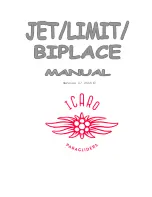
12/8/2006
FLIGHT TRAINING AND STANDARDS MANUAL
ECLIPSE 500
© Eclipse Aviation Corporation, 2006
55
Takeoff
Before every takeoff, consider the possibility of a rejected takeoff. The distance
required to accelerate to Vr and then reject the takeoff should be known. This
‘rejected takeoff distance’ can be estimated by adding 50% to the takeoff distance
(100% if flaps UP takeoff) and then compare to the available runway. If rejected
takeoff distance is greater than runway length, the pilot must use risk management
skills and assess and mitigate the situation.
For all takeoffs, keep one hand on the throttles until the decision to continue.
Monitor engine instruments and CAS during takeoff roll to be alert to any
abnormalities.
NOTE
Takeoff distance data contained in section 5 of the AFM assume that brakes are
held until both engines are at maximum available thrust.
Normal takeoff
With the airplane aligned on the runway centerline, release brakes, advance the
throttles to max and call out when the APR ARMED status message appears and
the airspeed comes alive. Accelerate to Vr and smoothly rotate to 10
o
.
When a positive climb is confirmed by observing an increasing altimeter indication,
raise the landing gear. Maintain 10° pitch attitude to 400’ AGL or obstacle
clearance, whichever is higher.
At 400’: Flaps - UP, Yaw Damper - ON, Throttles - MCT, Airspeed – as planned.
For a rolling takeoff, maintain normal taxi speed until aligned with the runway.
Then advance power to maximum thrust.
Short field/obstacle takeoff
If runway length is limited and/or there is a close-in obstacle, refer to the AFM
Performance chapter to determine takeoff performance margins. In position at the
very beginning of the usable runway, hold the brakes while advancing power to
maximum. Once the throttles are full forward and APR ARMED is observed,
release brakes. Rotate at the normal Vr. With a close-in obstacle, raise the gear
normally and climb at V
50
. When clear of the obstacle, accelerate normally.
Crosswind takeoff
The crosswind technique in the Eclipse is essentially like that of any tricycle gear
aircraft. Conventional crosswind correction is effective. Apply full aileron into the
wind as the airplane begins the takeoff roll. Gradually reduce aileron input as the
airplane accelerates. Lift off in a slip, immediately relaxing the slip into coordinated
flight and track the runway centerline (unless assigned a specific heading by ATC).
The maximum demonstrated crosswind limit is 14 knots.
















































